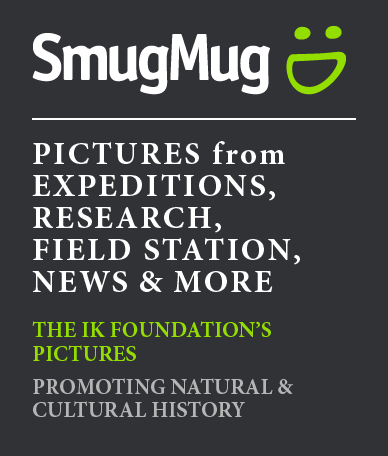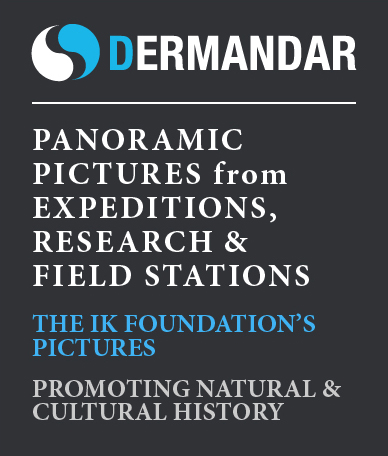ikfoundation.org
The IK Foundation
Promoting Natural & Cultural History
Since 1988





BACKGROUND
The BRIDGE BUILDER EXPEDITIONS is the overarching definition for a series of contemporary and scientifically sustainable projects established by The IK Foundation, an undertaking which aims to inspire and to contribute to our understanding of our shared planet! These projects are grounded in the concepts of retracing and lifting both practical and theoretical knowledge from the Linnaeus Apostles' journeys. The core of said projects revolve around a series of expeditions – with fieldwork in both rural and urban landscapes – which will be used to collect data and knowledge from several of the world's continents. This work incorporates a look into both cultural and societal values of specific regions as well as the measuring of the natural permutations of the landscapes travelled three centuries ago and if they have shifted with the passing of time. In essence the BRIDGE BUILDER EXPEDITIONS are a mixture of 18th century knowledge and 21st century know-how, two contrasting entities employed in unison to create an endeavour which is both interdisciplinary but also groundbreaking within its field. These contemporary expeditions offer insight into the developments and constants of the world we live in, divergences which lay the groundwork for new avenues of knowledge.NORTH AMERICA
The initial expedition within the project is the “BRIDGE BUILDER EXPEDITIONS – NORTH AMERICA” which follows in the footsteps of one of the most successful of The Linnaeus Apostles, Pehr Kalm (1716 - 1779). Kalm travelled to North America where he made numerous natural and cultural historical observations. The journey started in Sweden 5 October 1747 from Löfstad to Göteborg, by ship 30 November towards Norway where he visited Grömstad, Arendal and Kristiansand. He travelled to London 28 January 1748 where he arrived 7 February. Kalm stayed in England until 25 July, when he sailed towards America and anchored in the road of Philadelphia 15 September. Kalm’s travels in North America was concentrated to the areas; Pennsylvania, Delaware, New Jersey, New York and the southern part of present day Canada. He left the continent via Philadelphia, 13 February 1751 and arrived in London late April and stayed there very briefly before leaving for Göteborg and arrived in Stockholm 3 June 1751. More information on Kalm as a person and his work can be found in iFACTS and iMAPS.Kalm’s journals are among the most published, read and cited of the Linnaeus Apostles’ publications, the complete journal is also freely accessible as an iBOOK on this site. His often vividly detailed observations span both natural and cultural history. Kalm’s North American studies lasted for more than two years, in that time he followed known routes between communities primarily by rivers, lakes and other waterways, as they were both safer and more efficient than travelling by land. By these methods, he journeyed through some of the most easterly states and provinces of what is today the USA and Canada. His methods of collecting knowledge through fieldwork was through observing and conversing with the local inhabitants, methods which gave him in-depth knowledge of local traditions and the areas possibilities from an utilitarian point of view. This coupled with the long duration the stay and the geographical span which he covered, making his journal a vital key to understanding a continent on the brink of social and cultural transition.
AIMS & IDEAS
In addition to the overarching goals which are initially described in conjunction with the BRIDGE BUILDER EXPEDITIONS, the work will seek out what is unique with each chosen Apostle’s work and to study (a selection of):- How said Apostles’ knowledge (practical/theoretical) was used after their initial observations in respective countries?
- If their observations have been used in modern contexts to understand change/happenings or in various analyses?
- To document a selection of physical locations visited by each respective Apostle and to try and find points of connection between then and now?
- Comprehensive looks at what benefits and/or influence – if not primarily historical – their journals and documentations have had for their respective nations and subjects?
PUBLIC DOMAIN & CROWD SCIENCE
The BRIDGE BUILDER EXPEDITIONS are presented in detail on their dedicated sites under iPROJECTS within iLINNAEUS. Here anyone interested can receive visual and textual updates from our members in the field, as well as results which said expeditions will create. The results themselves will be accessible via iLINNAEUS under the Creative Commons licences which we operate within, as well as in printed articles and publications.Interested individuals and organisations with local knowledge within the geographical and subject areas which the expeditions will encompass are welcome to get in touch with the IK Foundation. What is today denoted as Crowd Science was something the Linnaeus Apostles had great adherence to. We are especially interested in reaching out to projects which have used or use modern interpretations of the Apostles' work in their own studies and research!
iPROJECTS
iPROJECTS
In The IK Foundation and The IK Workshop Society there are continually ongoing comprehensive projects, each having different character and format. In iPROJECTS the current works and ideas are presented - Expeditions, Fieldwork, Research, Presentation in progress, and much more... For regular updates, and to make full use of iLINNAEUS' possibilities, we recommend fellowship by subscribing to our monthly newsletter iMESSENGER.
NAME OF PROJECT
- (Main title) The Linnaeus Apostles
BRIDGE BUILDER EXPEDITIONS
To Understand Planet Earth - (Subtitle) BRIDGE BUILDER EXPEDITIONS - NORTH AMERICA
GEOGRAPHICAL SCOPE
- The United States: (States) Pennsylvania, New York, New Jersey and Delaware.
- Canada: (Provinces) Quebec and Ontario.
SUBJECTS
- Geography
- 18th century Studies'
- Cultural History
- History of Science
- Natural History
- Economic History
TIMELINE
- 2013 Preparation and fund raising.
- 2014-2016 Fieldwork, research, documentation and follow-up work.
- 2016-2017: Fieldwork, fund raising and follow-up work.
- 2017-2019: Fund raising and follow-up work.
- 2020-2023: Fieldwork and follow-up work.
- 2024-2025: Publicise.
PUBLICISE
- iLINNAEUS.org
- Publications and articles
- Exhibitions
PATRONAGE
This site/project has been made globally available in collaboration with:
 The Thora Ohlsson Foundation, Lund, Sweden
The Thora Ohlsson Foundation, Lund, Sweden
Barbara Groh-Wahlström, Brooklyn, USA/Båstad, Sweden
Lars Gårdö, former President and CEO of Atle AB, Stockholm, Sweden
Bertil and Elizabeth Lundqvist, New York, USA
Frost River, Duluth, USA
Feel welcome to read more about how to take part...
LINKS | FURTHER READING





Updated/Checked 27/09/2023
THE IK FOUNDATION & COMPANY PROMOTING NATURAL & CULTURAL HISTORY
SUBSCRIBE TO OUR NEWSLETTER
TRANSLATE PAGE
A link to this page has
been copied to your clipboard
SHARE @been copied to your clipboard




© The IK Foundation & Company 2025
– a truly European organisation since 1988
– a truly European organisation since 1988
Legal issues | Forget me | and much more...
How to cite & Creative Commons
You are welcome to use the information and knowledge from
The IK Workshop Society, as long as you follow a few simple rules.
LEARN MORE & I AGREE
You are welcome to use the information and knowledge from
The IK Workshop Society, as long as you follow a few simple rules.
LEARN MORE & I AGREE











